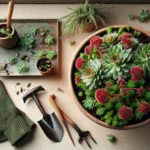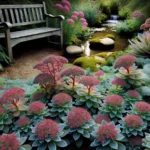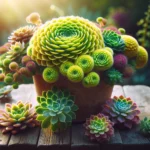Introduction to Sedum Nussbaumerianum
Welcome to the dazzling world of Sedum Nussbaumerianum, a true gem among succulent aficionados! Often bathed in the warmth of the sun, these plump, radiant beauties hail from the rocky cliffs of Mexico, captivating gardeners with their fiery-tinted foliage. Commonly known as ‘Coppertone Stonecrop’ or ‘Nussbaumer’s Sedum,’ they’re not just plants; they’re living sculptures adding zest to any garden landscape.
What sets the Sedum Nussbaumerianum apart is its remarkable ability to morph colors like a sunset over the ocean. From rich greens when shaded to oranges and deep crimsons under the full sun, it’s a chameleon in plant form. Imagine your rock garden, spruced up with these little sun seekers, transitioning through seasons with their colorful display – it’s no wonder they’re celebrated so widely!
Still, this succulent’s charm doesn’t stop at its vibrant tones. It’s hardy, drought-tolerant, and as low-maintenance as they come. Perfect for both the seasoned gardener or the green-thumbed beginner looking to dip their toes into the fascinating world of succulents. For those eager to learn more about succulent care, explore the ultimate guide to nurturing these hardy plants. It’s an insightful read packed with tips to keep your leafy friends thriving.
Sedum Nussbaumerianum, with its sun-kissed foliage, exemplifies nature’s magic in your very own home. In the plant world, it’s akin to finding a treasure chest brimming with gold – no treasure map needed!
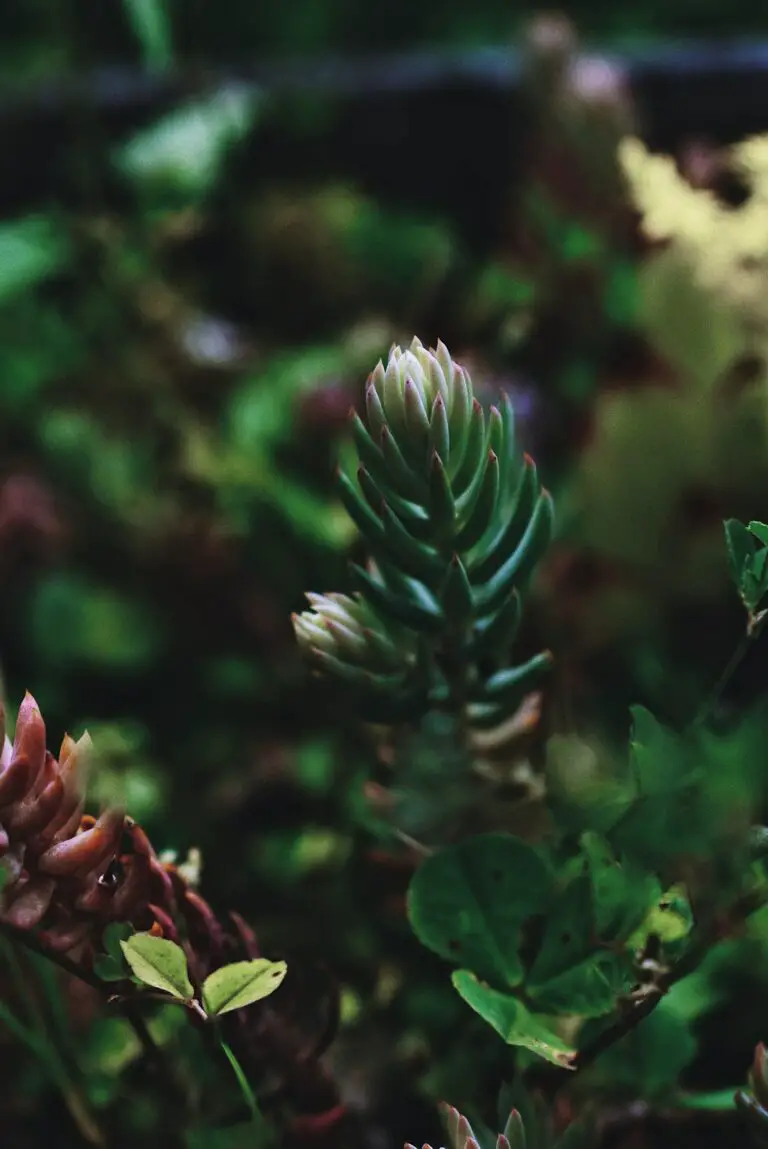
Distinctive Traits of the Nussbaumer’s Sedum
Imagine a succulent that paints your garden with its stunning copper hue, and you have the Sedum Nussbaumerianum, fondly known as Nussbaumer’s Sedum. This ravishing plant is a conversation starter, with its copper-toned leaves shimmering under the noonday sun. Indeed, gardening is akin to creating a living tapestry, and the vivid, evergreen foliage of Sedum Nussbaumerianum is the perfect brushstroke against any canvas of green. Each plump leaf is a testament to this succulent’s vitality, exuding a warm glow that is particularly vibrant when the plant basks in the full glory of the sun.
But let’s untangle the mystery behind these fiery leaves. The alchemy of coloration in Sedum Nussbaumerianum is a fascinating dance of nature – exposure to the sun’s rays coaxes out the copper-red shades, emboldening the plant’s naturally green pigments. A more shaded environment may cause the Sedum to lean into soft greens and yellows, subtly hinting at the fiery potential within. Trust me, it’s not just about aesthetics; these color changes signal adaptability and resilience that give the Sedum an edge in the survival stakes of the plant world.
Speaking of infusing beauty into your space, those who have ventured into the realm of succulent care will know that Sedum Nussbaumerianum doesn’t just elevate your garden’s appeal; it’s surprisingly straightforward to nurture. The plant’s easy-going nature means that whether you’re an expert gardener or a weekend hobbyist, the Sedum is your sturdy, stress-free companion. Even so, to maintain its distinguished appeal, it’s crucial to nail its minimal, yet specific, care needs – this is not a plant that thrives in anonymity.
To dive deeper into the care specifics and watch these vibrant leaves come to life, I highly recommend this visual aid. This engaging video not only showcases Nussbaumer’s Sedum in all its glory but also offers valuable insight into nurturing your golden gem:
Ultimately, the delicate interplay between environment, sunlight, and care coalesces into the essence of the Sedum’s beauty. With the right conditions, what you get is more than just a plant – you get a living, breathing work of art that commands attention and captivates hearts. The Sedum Nussbaumerianum isn’t merely an addition to your collection; it’s a statement piece that proclaims your garden as a sanctuary of extraordinary splendor.
Ideal Growing Conditions for a Healthy Plant
If you’re curious about turning your thumb green with dainty Sedum Nussbaumerianum, also known as Coppertone Stonecrop, you’re in for a treat! This succulent gem rewards gardeners with a kaleidoscope of color when given just the right touch of TLC. Let’s dig into the nitty-gritty of what it takes to make these botanical treasures thrive.
Sunlight: Basking in the Glow
The secret to seducing those vibrant hues out of your Sedum Nussbaumerianum? Sunlight, and lots of it. Imagine each ray of sun painting your plant’s leaves with strokes of copper and gold, much like an artist brings a canvas to life. To simulate these blissful sunbaths at home, aim for a south-facing window where these sun worshipers can soak in a minimum of six hours of indirect, yet bright, daylight. But, a cautious note – too much direct sun can lead to a sunburnt succulent, and nobody wants that!
Temperature: Cozy and Comfy
Just as we layer up or shed clothes with the changing seasons, Sedum Nussbaumerianum prefers a wardrobe of the right temperature ranges. It’s quite the fan of a mild climate, enjoying temperatures that stay between 50°F and 70°F (10°C and 21°C). While it can handle a slight chill, frost is as unwelcome as a snowball in the face, so bring your green buddies indoors when winter’s bite gets too sharp.
Soil: The Perfect Foundation
A succulent’s dream soil is like a comfy bed: it’s got to have just the right firmness and support. For the Sedum Nussbaumerianum, well-draining soil is the five-star mattress it craves. You can whip up a perfect mix with a combination of potting soil and sandy grit or perlite, creating a fluffy yet sturdy haven for roots to spread without water-logging their toes. Remember, wet feet might be fun at the beach, but in the plant world, it’s an invitation for rot to set in.
Wondering where to learn more? Venture over to this detailed care guide for the inside scoop on all things Sedum Nussbaumerianum. And if you’re in the market for insights into cultivating an orchestra of other succulents, our Ultimate Guide to Succulent Care is the backstage pass you need.
Now, let’s roll up those sleeves and watch as your Sedum Nussbaumerianum not only survives but outright flourishes under your green-thumbed command. And to truly bring your care game to the next level, here’s a video brimming with tips to keep your succulent sensation at its peak:
Watering and Feeding Schedule
As a gardener’s gem, Sedum Nussbaumerianum not only captivates with its fleshy, orange-hued leaves but it also thrives with the right sips and sups. To keep this succulent shimmering in health, there’s an art to balancing its water and nutrients—let’s dive into how you can master it.
Diligent watering ensures your Sedum Nussbaumerianum remains a stunner, but what’s the sweet spot? Unlike your thirst-quenched tomato plants, this succulent serenades in the subtle language of ‘less is more.’ Aim for a watering routine that moistens the soil thoroughly, allowing it to dry between sessions. Picture a downpour in its native rocky outcrops—intense yet infrequent. That’s your cue for watering: a deluge followed by dormancy.
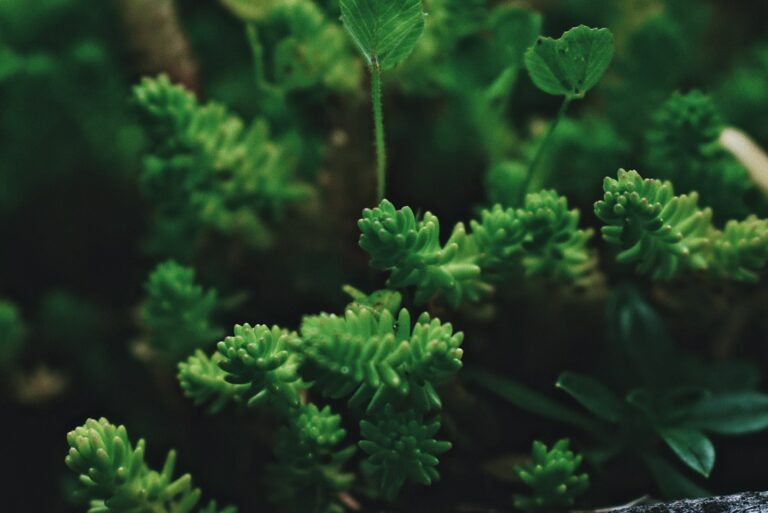
And when it comes to nourishment, a light feed will have your Sedum Nussbaumerianum basking in glory. During its growing season in spring and summer, treat it to a half-strength, balanced fertilizer every four weeks. Imagine serving a fine dining portion—exquisite and measured—not an all-you-can-eat buffet.
But beware of overindulgence! Muddied, squishy leaves whisper the tale of overwatering, while a pale complexion suggests a cry for nutrients. When faced with such distress signals, fine-tune your approach—ease up on the watering can, or offer a nutrient boost, as needed. Remember, gardening is not just a practice, it’s a relationship; it’s about observing, adjusting, and cultivating a conversation with your green companions.
By integrating these watering and feeding practices, your Sedum Nussbaumerianum will continue to gleam in the succulent world, much like a well-cared gem upon the gardener’s crown.
Propagation Methods Unveiled
Let’s roll up our sleeves and dig into the fascinating journey of propagating Sedum Nussbaumerianum, also fondly known as Nussbaumer’s Sedum. This succulent gem, with its alluring coppery-orange leaves, stirs excitement among gardening aficionados and novices alike.
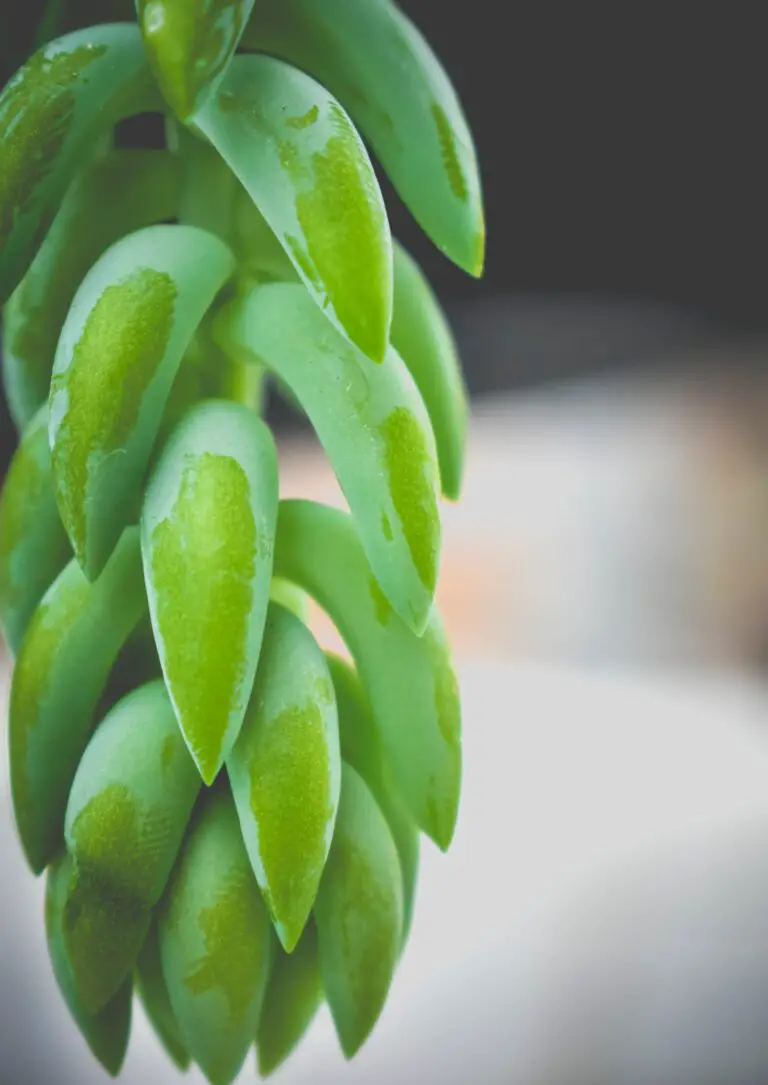
Imagine harnessing the power to create an army of these radiant plants from just a single leaf or cutting. Yes, it’s possible, and I’m here to guide you through the “propagation promenade” with insights that will have your succulents multiplying like magic.
Starting Off: Leaf Propagation
Engage with leaf propagation, a simple yet gratifying method. Choose a healthy, plump leaf from your existing plant. Gently wiggle the leaf back and forth until it snaps off. Here’s a pro-tip: Ensure a clean break to avoid damaging the leaf’s base, as this is where new roots will emerge.
Rest the leaves on well-draining soil and resist the urge to water them frequently—patience is your best friend here. Within weeks, tiny roots and rosettes will start playing peekaboo from the leaf’s base.
Branching Out: Stem Cuttings
When precision takes the stage, stem cuttings are your act. With clean shears, make a cut on a non-flowering stem, and let it callous over for a few days. Once the end hardens, it’s showtime. Plant the stem cutting into the soil, and in a few weeks, witness the birth of new growth.
The seductive dance of timing and technique in stem cutting ensures a spectacle of successful propagation. It’s like unlocking a treasure trove in the garden—before you know it, you’ll be the proud parent to a cornucopia of Sedum Nussbaumerianum offspring.
Embark on this propagation journey, punctuated by the thrill of watching life take root from the smallest fragment. It’s an experience that ties the gardener to the very essence of creation, an intimate waltz with nature that every plant lover should revel in.
Common Pests and Problems
Every gardener dreams of a flourishing collection of plants, and the uniquely colored Sedum Nussbaumerianum is often a standout gem. However, even the most robust succulents can succumb to the stealthy advances of pests. Imagine walking out to your green oasis and noticing your prized plant’s leaves looking a little lackluster. Upon closer inspection, you spot tiny culprits leaving their mark:
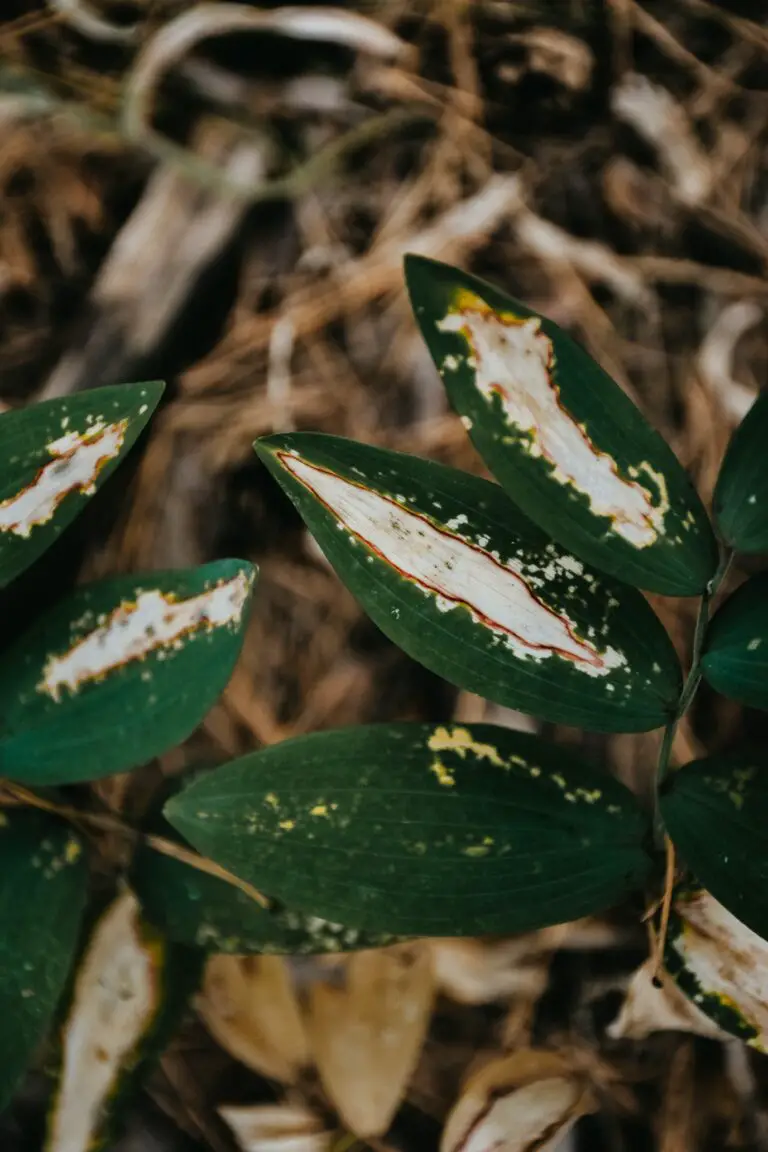
Let’s discuss some of the tiny trespassers like aphids, mealybugs, and spider mites, all of which are fond of the sweet sap of your Sedum Nussbaumerianum. These pests are the usual suspects when it comes to succulent drama. Tiny yet voracious, they can do significant damage if left unchecked.
Organic Solutions to Aphids & Mealybugs
When it comes to aphids, these little green or black goblins can multiply quickly. In a real-life scenario, Ann, a seasoned succulent enthusiast from Santa Fe, noticed aphids on her Sedum Nussbaumerianum and immediately sprang into action. By spraying a homemade mixture of water, a few drops of dish soap, and neem oil on the affected areas, she was able to stop the aphids without harming her plant. It’s a perfect example of how organic remedies can be both effective and eco-friendly.
Spider Mite Showdown
Then there are the spider mites, those tiny web-spinning villains. Unlike the action-packed Spider-Man, these critters are no heroes in the garden. They suck sap from the underside of the leaves, causing a dusty, gray appearance. It’s crucial to play vigilante with these pests — at the first sign of their delicate webs, cleanse your Sedum Nussbaumerianum with a forceful stream of water or introduce predatory insects like ladybugs, who gorge on mites much like they would on a buffet.
Combatting Common Diseases
Aside from pests, diseases can also plague Sedum Nussbaumerianum. Take root rot, for instance. It’s often a death sentence for succulents if not caught early. The best defense? Prevention. A proper watering schedule and well-draining soil are the succulent’s armor against this insidious condition.
Environmental Stresses
Environmental stresses can make your Sedum Nussbaumerianum vulnerable to both pests and diseases. Consider the plant’s lighting needs — intense direct sun can scorch leaves, while too little light can weaken its defenses. Regularly assessing your plant’s environment and adapting care routines accordingly can maintain its vigor, making it less likely to fall victim to the aforementioned foes.
Understanding the signs and implementing timely, organic solutions will keep your Sedum Nussbaumerianum healthy and your garden thriving. After all, each leaf saved is a testament to your green thumb and the resilience of this succulent treasure. Don’t let pests and problems dim the verdant glow of your gardening gem!
Landscape and Decorative Uses
Picture this: the lush, green tapestry of your garden, punctuated with the rosy-orange hue of Sedum nussbaumerianum, a true gem among succulents. But how do you make this image a reality in your own space? It’s simpler and more enchanting than you might think!
Whether it’s a sun-kissed rockery or the cozy corner of your study, Sedum nussbaumerianum brings warmth and texture to your green spaces. For an outdoor setting, intermix these flame-tinted succulents with cool-toned greens for a visually arresting contrast. An easy trick is to plant them alongside silver-leaved companions like dusty miller or blue fescue — think of it as nature’s own color wheel at work!
Indoors, these succulents transform into living sculptures. Arrange a collection of Sedum nussbaumerianum in terracotta pots on a sunny windowsill, and watch them glow like the setting sun. Keep it simple or get creative by mounting them on driftwood pieces for a more organic aesthetic. For those with a knack for DIY, creating a succulent frame with these beauties can turn your wall into a vertical garden that demands attention.
Don’t just take our word for it. Here’s a video showcasing the transformational power of this versatile succulent in a variety of settings, from repotting to creating stunning visual landscapes. It’s not just about planting; it’s about creating spaces that speak to your soul.
Moving beyond pots, consider these vibrant plants for living borders or garden pathways. With their drought-resistant nature, Sedum nussbaumerianum makes for a low-maintenance yet striking edge along your walkways. In fact, a well-thought-out arrangement can guide visitors through your garden as if they were on a journey through an enchanted landscape.
Finally, let’s not forget the element of seasonality. As fall approaches and most plants prepare to rest, your Sedum nussbaumerianum shifts into higher gear, its colors deepening to an almost fiery hue. It’s the perfect time to spotlight them against evergreens or ornamental grasses, ensuring your garden remains a focal point of natural beauty year-round.
Bringing Nature Indoors with Sedum Nussbaumerianum
When it comes to interior decoration, the adaptability of Sedum nussbaumerianum really shines. They’re not just plants; they’re conversation starters, mood lifters, and a constant reminder of nature’s resilience. This succulent doesn’t clamor for the limelight but somehow always manages to steal the show, whether it’s part of a minimalist design or a more eclectically styled space.
There you have it – a plethora of creative ways to weave the unique charm of Sedum nussbaumerianum into the fabric of your landscape and living spaces. With this succulent in your gardener’s palette, the possibilities are truly endless.
Frequently Asked Questions
Whether you’re a green thumb or just starting your gardening journey, understanding the care specifics for the delightful Sedum Nussbaumerianum can transform your experience with this succulent gem. Let’s dive into some common curiosities!
What is the ideal temperature for Sedum Nussbaumerianum?
Thriving in the warm embrace of the sun, Sedum Nussbaumerianum adores temperatures ranging from 60°F to 80°F (15°C to 27°C). While it can endure cooler nights, frosty conditions are a strict no-go. Imagine this sun-loving succulent as your beach-going buddy – it loves a good sunbath but wouldn’t dare to touch the snow.
Can Sedum Nussbaumerianum thrive indoors?
Absolutely! This hardy succulent can jazz up your indoor spaces just as well as it does any outdoor garden. Place it near a south-facing window where it can soak up some rays, and watch it brighten your room with its vibrant, orange-hued leaves – much like the warm glow of a cozy sunset corner in your living room.
How often should Sedum Nussbaumerianum be watered?
Consider the watering can as your watering wand – wield it wisely. Sedum Nussbaumerianum prefers a soak-and-dry method, needing water only when the soil feels like a parched desert. Overwatering is like overindulging; it appreciates moderation. Observe the topsoil – once it’s dry to the touch, it’s time to quench its thirst. Remember, you’re aiming to maintain a succulent, not start an aquarium!
What are the signs of overwatering in Sedum Nussbaumerianum?
Watch out for squishy, translucent leaves – a tale-tell sign of too much H2O. Overwatering can make your precious plant’s roots feel like they’re in a swamp, leading to root rot. If the leaves start to look like they’ve had a few too many drinks, it’s time to cut back on your watering schedule.
How can I propagate Sedum Nussbaumerianum successfully?
Propagation is a piece of cake with this succulent. Snip off a healthy leaf or stem, let it callous over for a day or two to prevent infection, and then simply place it on well-draining soil. Keep the faith and in time, you’ll witness tiny versions of the plant sprouting like magic. It’s the plant world’s version of a cloning spell!
For a visual guide on propagation and care, take a peek at this helpful video:
Are there any toxic effects of Sedum Nussbaumerianum on pets?
Good news for pet owners – Sedum Nussbaumerianum is non-toxic to cats and dogs. However, it’s still wise to keep it out of reach as a precaution, because over-curious pets might treat it like a chew toy. And let’s be honest, your succulent would much rather be admired for its beauty than nibbled on by your furry friend!
